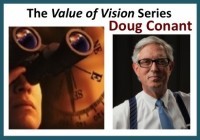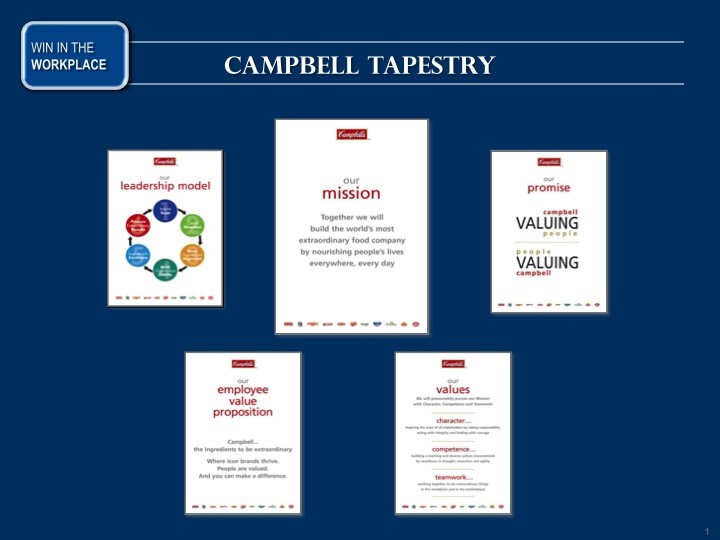 I had the pleasure of interviewing Doug Conant, newly appointed Non-Executive Chairman of Avon and the former President and CEO of Campbell Soup, where he led the company through a dramatic transformation, reversing the declining trend in earnings and employee engagement. Under his leadership, the company generated quality sales growth and some of the best employee engagement rankings in the industry for ten consecutive years.
I had the pleasure of interviewing Doug Conant, newly appointed Non-Executive Chairman of Avon and the former President and CEO of Campbell Soup, where he led the company through a dramatic transformation, reversing the declining trend in earnings and employee engagement. Under his leadership, the company generated quality sales growth and some of the best employee engagement rankings in the industry for ten consecutive years.
I am delighted to be able to share Doug’s views on vision here. ~Jesse
What do you observe about people’s attitudes toward vision these days, Doug?
One thing I’ve observed in all of my speaking, from millennials at Google to boomers at Vanguard, is that people today are less interested in the vision and more interested in “how to.” They are trying to get a sip of water from the fire hydrant of life, and it’s washing over them.
They are overwhelmed with everything that is coming at them. They get hundreds of emails a day. They are flooded with demands. And just when they start to get out from under the pile, they get a call from school that Johnny isn’t feeling well. They are trying to push everything away so they can do their work, and they’re looking for “how to” answers like time management tricks.
So how can leaders respond to this?
We need to help them understand that managing the complexity of these multiple demands and competing priorities IS their work.
This is one of the challenges of 21st century leadership. We are living in a new paradigm, and we need to learn to deal with it. The environment is changing, and it’s demanding that we rethink the leadership model in today’s frenetic environment. But the principles hold up.
You said “the principles hold up” – what are they?
An organization needs an aspirational goal that is relevant and transformational and is about more than just “doing business every day.” Work has to be meaningful. A transcendent goal that people can connect with helps them stay engaged and motivated.
Vision itself is necessary, but it’s insufficient. The challenge for a leader is to craft an aspirational vision in a collaborative way with the organization, and also to craft a perspective of how to bring it to life in a tangible way – a path forward.
How is that different now?
In the old hierarchical model you could just tell people what the vision was. That won’t work now. We have to create a platform that is meaningful for each person.
Leaders can’t do it alone. They must do it in collaboration with their leadership team, and if they’re doing it really well, with the entire organization. The vision has to be collaboratively created and open in its architecture so people can connect with it.
What might a platform that everyone can connect to look like?
We did that at Campbell and now at Avon by building a tapestry. In the tapestry, there’s something for everybody. If you’re analytic you’ll be drawn to one place. If you’re people-centric you’ll be drawn to another. It weaves the big picture of who we are and where we’re going.
People can grab ahold of it in the way that works for them and become personally accountable. They can ask themselves everyday, “Am I operating within the spirit of the vision?”
You talk about both personal and organizational vision. What’s the relationship?
When the company’s vision is clear, you can see how much it overlaps with your own goals, values and dreams.
It’s like a Venn diagram. The overlap is where it works. If it doesn’t overlap, you’re in the wrong place.
So what about you? What’s your personal vision as a leader?
I remember years ago, my CEO of Nabisco had his executive team complete a personal style assessment. He was very intrigued by studying different thinking styles. I came out on that thinking style quiz as an “idealist-realist.” There were examples of roles for each of the thinking styles and mine was a nurse. I thought about it a bit, and it made sense to me. Nurses have a vision of serving people and society in a compelling way. But they are also willing to roll up their sleeves and deal with the blood and guts of the situation. They are there to serve and to make the world a better place, and they do it in tangible way. I now think of myself, in many ways, as a corporate nurse.
People want the idealism and also a leader who is dealing with the reality of everyday so there’s a likelihood it will get done.
And that’s what my life’s work is about now: Improving the quality of leadership in the 21st century.
 Doug Conant, Founder of ConantLeadership, is the Non-Executive Chairman, Avon Products, the Former President, CEO and Director, Campbell Soup and the Former President of Nabisco Foods. Founder and Chairman of the Kellogg Executive Leadership Institute at Northwestern University, Chairman, CECP (Formally known as the Committee Encouraging Corporate Philanthropy), member of the Board of Directors, AmerisourceBergen Company. New York Times Best-Selling Author of Touchpoints: Creating Powerful Leadership Connections in the Smallest of Moments and noted Speaker and Author on the subject of leadership in the 21st century. Follow Doug’s journey on the ConantLeadership website and join the leadership conversation:
Doug Conant, Founder of ConantLeadership, is the Non-Executive Chairman, Avon Products, the Former President, CEO and Director, Campbell Soup and the Former President of Nabisco Foods. Founder and Chairman of the Kellogg Executive Leadership Institute at Northwestern University, Chairman, CECP (Formally known as the Committee Encouraging Corporate Philanthropy), member of the Board of Directors, AmerisourceBergen Company. New York Times Best-Selling Author of Touchpoints: Creating Powerful Leadership Connections in the Smallest of Moments and noted Speaker and Author on the subject of leadership in the 21st century. Follow Doug’s journey on the ConantLeadership website and join the leadership conversation:
Twitter | Facebook | LinkedIn | YouTube | Pinterest | Instagram | Google+















Doug always inspires me. He hits the nail on the head about vision saying, “In the old hierarchical model you could just tell people what the vision was. That won’t work now. We have to create a platform that is meaningful for each person.”
Somewhere we got confused with the Vision thing. We thought it was important to create Vision Statement which we announced and hung on the wall. What we needed to do was to create an Inspiring Vision that compelled others to take up the charge. That’s what a Vision is supposed to do.
I think you hit the nail on the head, Dan. Somewhere along the line, people started confusing “vision” with “vision statements,” thinking they were the same thing. Much thanks for sharing your insights here.
Love this – “People are trying to get a sip of water from the fire hydrant of life, and it’s washing over them.” I think we’re all struggling to figure out how to manage everything that’s coming at us.
I think one of the things that can help is to get more clear on your own personal vision. It was interesting to read Doug Conant’s vision that his role as a leader is a “corporate nurse.” It inspired me to think about how I see my role. Great food for thought!
Hi Robert, Glad to hear you’ve been inspired to think about your own vision. Having a deeper connection with yourself is the best way to keep from being “washing over by the fire hydrant of life.” You might find this helpful as you consider it: Dig Below Your Dreams to Discover Your Vision
Hi Jesse
I agree with Dan Forbes in his comment above…..it’s obvious that leaders and organizations have to create a platform that is meaningful for each person.
I recently read a stat where an estimated 70% of American workers are dissatisfied with their job and are not content. In the old days, leaders could just tell their team what their vision was and that was enough. Not anymore. Work has to be meaningful. Doug’s comment about a transcendent goal that people can connect with will help them stay engaged and motivated is so important for leaders and organizations to hear.
Thanks for the great series.
LaRae
Thanks, LaRae, I agree that when work is meaningful and connected with what we truly care about, it is much more satisfying and we are naturally motivated to put in effort. I am struck by Doug’s comment about how many people are overwhelmed and more focused on their next step than on the horizon. The only way to come up with a transcendent goal that people resonate with is to involve them in the process of identifying it.
Glad you are enjoying the series, LaRae. I’ve appreciated your contributions to the conversation.
Hi Jesse it was a very good interview.
Doug made several good points:
1. To many people are overwhelmed today and taking a sip from a fire hydrant is a great analogy.
2. That successful businesses have vision, goals, and principles that overlap with those of their people. And without the overlap you do not get anyplace. In fact I would say it also need to overlap with your customers and consumers.
3. That mandating things instead of collaborating to create is less effective. Today you need people to buy in, and without their involvement it does not happen very often.
4. One size fits all does not work, whether communicating, drawing out ideas, or developing your team, you have to use a wide range of tools, methods, and systems, to maximize the result.
A nice summary of Doug’s major points, Robert. Glad you enjoyed the interview. Also appreciate your point that vision must overlap with that of customers and other stakeholders.
Hi Jess
Playing a little catch up here, so apologies for the tardy reply. I think that Doug makes a number of interesting points, not least the one about aligning personal and organisational vision. This is particularly because a compelling vision must be underpinned by values … and for the vision to be delivered those values must resonate across the organisation. Hence the absolute need to create a platform for all staff to freely engage and to experience the overlap between their own personal values, vision and goals and those of the organisation. Where dissonance occurs is often, in my experience, because corporate values no longer appear to be aligned to my own.
So … organisations need to ditch the ‘command and control’ model of yesteryear, and really engage with their employees. Amazingly many organisations have yet to do this and I wonder what makes them so risk averse!Performance would be so outstripped if they did properly engage with their staff! Thanks for the series – I have really enjoyed it!
John, I am amazed, too, at how many organizations have yet to do this, especially since we’ve been aware of the failures of that model since the 1970’s. Consider Tom Peter’s research in the 1980’s – command and control did not show up in any of the excellent organizations he identified. Study after study has shown we must engage the hearts and spirits of the members of the organization for it to thrive. Instead, leaders shrug their shoulders as though it’s out of their hands as the dismal employee engagement figures come in year after year. And if any of them say it can’t be done, I would tell them to take a look at what Doug Conant did at Campbell Soup – in this century! I have personally worked with many courageous leaders who have done it as well. It’s not just theoretical. It can be done. We need to demonstrate it so people can begin to imagine a different way, and take a step in that direction.
Glad you have enjoyed the series, John. I appreciate the insights you have shared.
I LOVE the concept of building a tapestry from which everyone can draw personal meaning and weave in the application of the vision to their day to day business dealings.
I’ve noticed similar issues to Doug when he says: “People today are less interested in the vision and more interested in “how to.””
Despite promoting my courses on strategic communications as – well, strategic! – I notice how, when given the opportunity to apply what we’ve just covered to their own organizational needs, so many participants default to tactics. They want the “how” even though they don’t fully understand the “why.” They jump straight to which social media they should be “on” without taking the time to consider why they need to be on social media in the first place, what they plan to say and how they’re going to rise above all that din with a compelling message.
This may have something to do with the pace of life these days, illustrated by a post I saw just the other week, stressing that today’s leaders need to accomplish things in their first 10 days, not the 100 days “of old.” http://m.strategy-business.com/article/What-You-Should-Accomplish-in-Your-First-10-Days?gko=da69a. Sheesh….I used to think that expecting results on a quarterly basis was ambitious.
Vision (strategy) needs time to gestate, to percolate. There’s no point management focusing on doing things right if the direction is wrong in the first place. We get what we reward. Certainly, Doug is correct in pointing out that organizations need to be sure each employee can personally connect with the vision and make it their own. But if the emphasis is on fast results and tactical imperatives …then it may be that those good intentions result in very little of long-term value.
Hi Liz, You make an excellent point that vision needs time to gestate and may be out of sync in our instant on-demand world. We pay a long-term price for a short-term win.
Thanks so much for sharing your insights here (and for all your efforts to communicate your salient thoughts). Great to have you join the conversation!